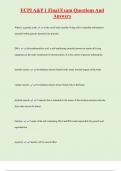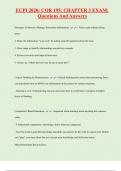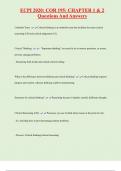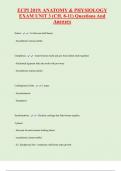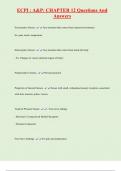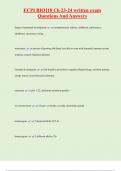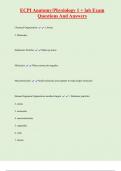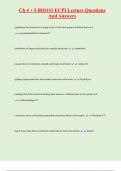Ecpi
Latest uploads at Ecpi. Looking for notes at Ecpi? We have lots of notes, study guides and study notes available for your school.
-
298
- 0
-
8
All courses for Ecpi
Latest notes & summaries Ecpi
ECPI A&P 1 Final Exam Questions And Answers What is a genetic code is the set of rules used by living cells to translate information encoded within genetic material into proteins. DNA deoxyribonucleic acid, a self-replicating material present in nearly all living organisms as the main constituent of chromosomes. It is the carrier of genetic information. smooth muscle Involuntary muscle found inside many internal organs of the body cardiac muscle Involuntary muscle tissue found only in ...
ECPI 2020: COR 195: CHAPTER 3 EXAM: Questions And Answers Strategies To Process, Manage, Remember Information: 1. Never read without taking notes 2. Make the information "your own" by asking yourself questions about the topic 3. Draw maps to identify relationships amount key concepts 4. Revise your notes and maps at least once 5. Always as, "what's the best way for me to learn this"? Critical Thinking & Memorization: - Critical thinking takes more than memorizing facts -...
ECPI 2020: COR 195: CHAPTER 1 & 2 Questions And Answers Umbrella Term: Critical thinking is an umbrella term that includes the terms critical reasoning (CR) and critical judgement (CJ). Critical Thinking: - "Important thinking" you need to do to answer questions, or assess , prevent, manage problems. - Reasoning both inside and outside clinical setting What is the difference between thinking and critical thinking? Critical thinking requires purpose and control, whereas thinking...
ECPI 2019: ANATOMY & PHYSIOLOGY EXAM UNIT 3 (CH. 8-11) Questions And Answers Suture: - In between skull bones - Synarthrotic (immoveable) Gomphosis: - Joint between teeth and jaw bone (holds teeth together) - Peridontal ligament links the tooth with jaw bone - Synarthrotic (immoveable) Cartilaginous Joints: 2 types: - Synchondrosis - Symphysis
ECPI : A&P: CHAPTER 12 Questions And Answers Exoreceptive Senses: Any sensation that comes from external environment Ex: pain, touch, temperature Interoceptive Senses: Any sensation that comes from inside the body - Ex: Changes in viscera (internal organs of body) Proprioceptive Senses: Pressure/position Properties of General Senses: Senses with small, widespread sensory receptors, associated with skin, muscles, joints, viscera
ECPI BIO118 Ch 23-24 written exam Questions And Answers Stages of postnatal development neonatal period, infancy, childhood, adolescence, adulthood, senescence, dying senescence process of growing old (body less able to cope with demands, immune system weakens, sensory functions decline) neonatal development first breath is powerful to expand collapsed lungs, newborn primary energy source=stored fats and colostrum autosome pair 1-22, determine traits(non-gender)
ECPI Anatomy/Physiology 1 + lab Exam Questions And Answers Chemical Organization 1.Atoms 2. Molecules Subatomic Particles Make up atoms Molecules Where atoms join together Macromolecules Small molecules join together to make larger molecules
Ecpi : Anatomy & Physiology Final Cumulative Exam Questions And Answers Clast- Break Blast- Bud Sarco- Flesh Epi- Upon Seb- Grease Astr- Star
Ch 4 + 5 BIO111 ECPI Lecture Questions And Answers epithelium that consists of a single layer of cells that appears stratified but is not pseudostratified columnar ET breakdown of larger molecules into smaller molecules catabolism muscle that is involuntary, striated, and singly neucleated cardiac M splitting larger molecules into smaller molecules with water Hydrolysis cartilage that forms shock absorbing pads between vertebral bones of the spinal cord fibrocartilage CT

